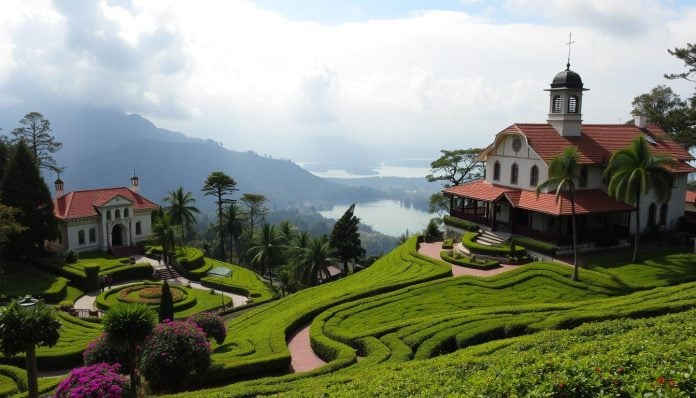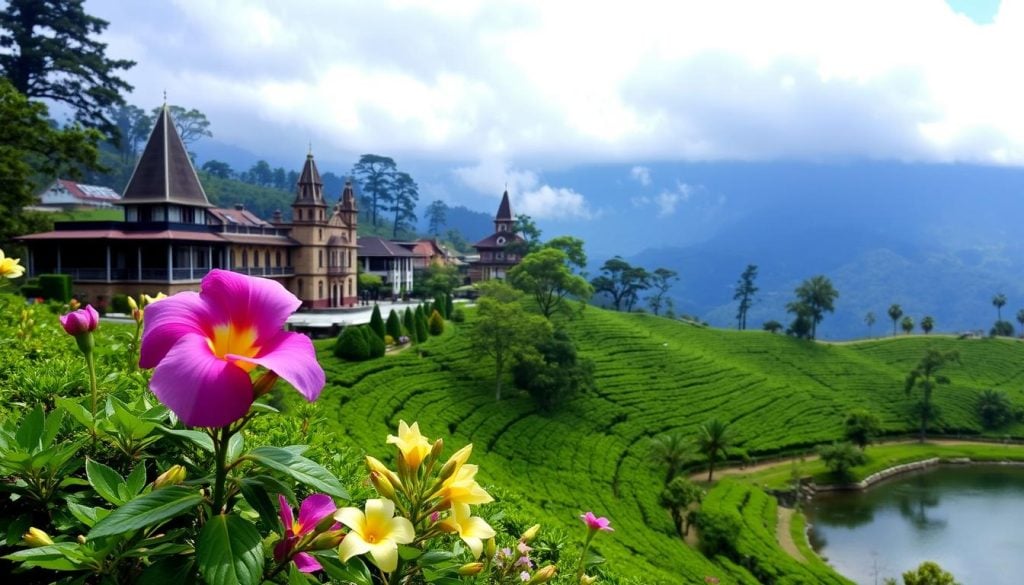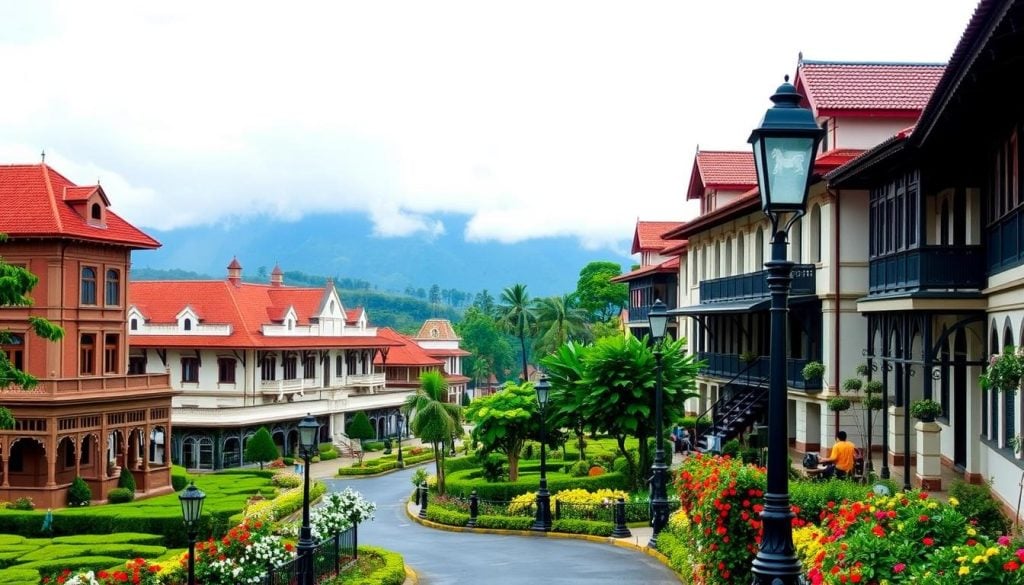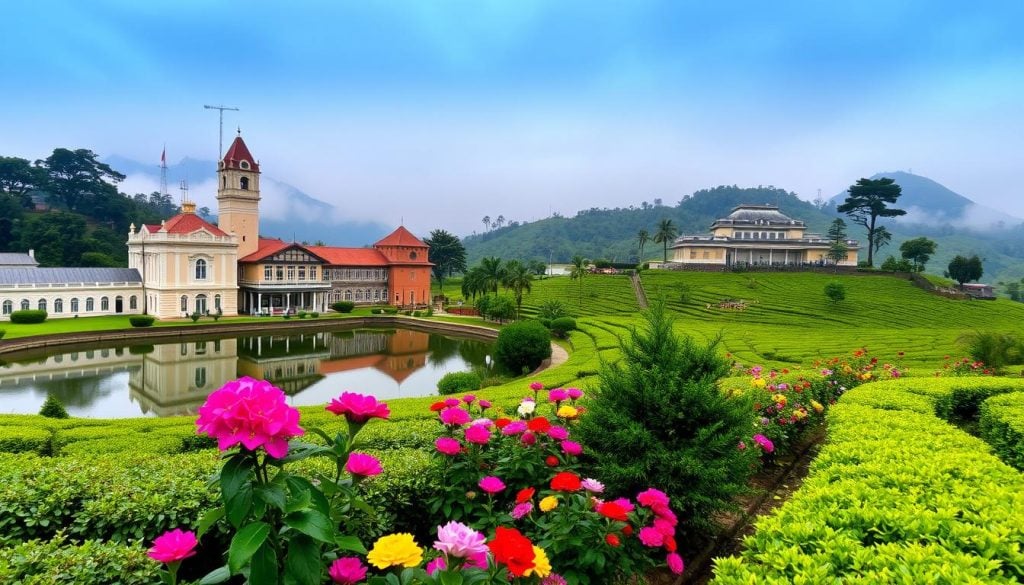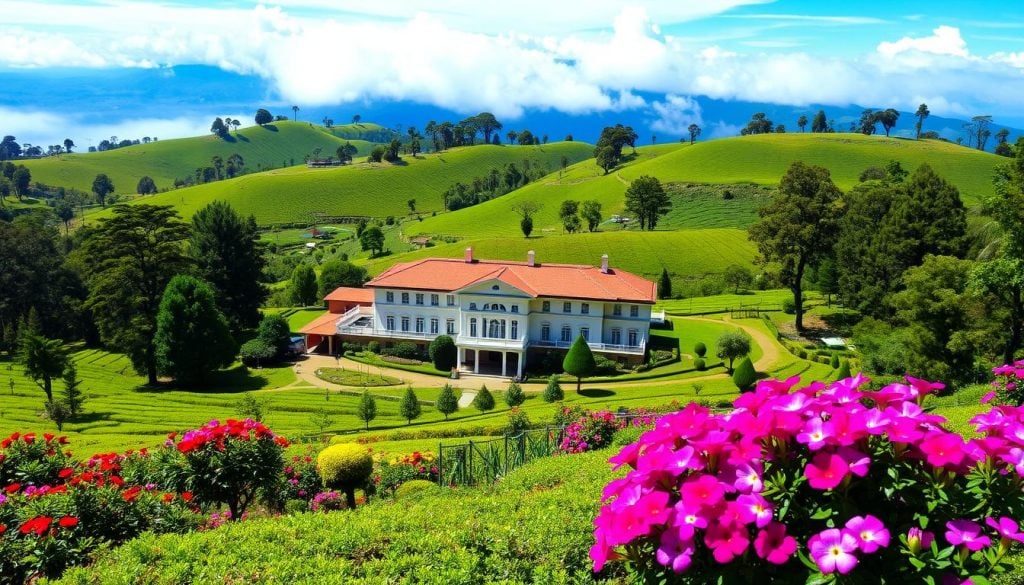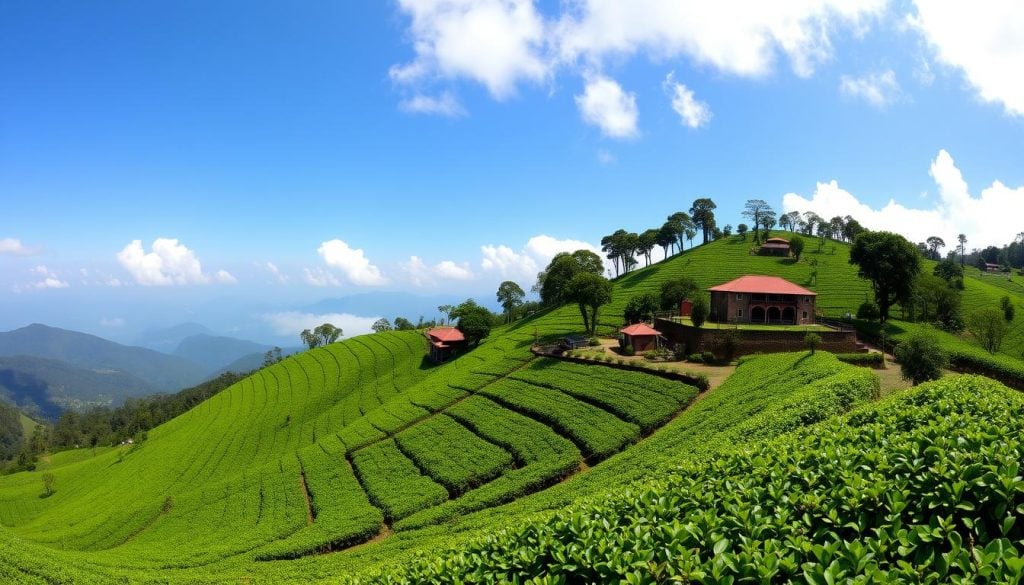Have you ever wondered how a single town in Sri Lanka became a vibrant canvas of colonial history, breathtaking scenery, and rich culture? Nuwara Eliya, often referred to as “Little England,” is a treasure trove of historical sites waiting to be explored. Nestled in the lush central highlands, this charming town invites you to journey through its fascinating past.
From the stately colonial-era buildings to the famous tea plantations that helped shape its identity, Nuwara Eliya tourism offers more than just beautiful views. Your adventure through this captivating locale will reveal the stories behind its historical sites. These stories illuminate their impact on Sri Lanka’s broader history.
As you delve into the allure of Nuwara Eliya, prepare to be captivated by the rich tapestry of experiences that awaits you.
Introduction to Nuwara Eliya
Nuwara Eliya, also called “Little England,” is a cozy retreat in Sri Lanka’s cool central region. It started in 1846 and keeps its colonial charm alive. The climate is cool, a nice break from the tropical heat elsewhere.
The area is known for its lush tea plantations, stunning waterfalls, and views. It’s perfect for those who love sightseeing in Nuwara Eliya. You can walk through green hills or enjoy Ceylon tea at a local estate.
Exploring Nuwara Eliya reveals its natural beauty and cultural heritage. It’s a mix of history and nature, drawing visitors to its unique charm.
The Colonial Legacy of Nuwara Eliya
Nuwara Eliya is a key part of Sri Lanka’s rich colonial history. It was set up as a cool retreat for British officials. This mix of cultures is seen in its buildings and streets.
The British came here to escape the hot lowlands. This started Nuwara Eliya’s journey as a tourist spot.
The city’s buildings show off its colonial past. Look for gabled roofs, wooden verandas, and big gardens. Walking around, you’ll see many preserved buildings.
These buildings give a peek into the past. They show what life was like back then. You can see homes, government buildings, and old estates.
These places are not just beautiful. They tell stories of the past. Exploring them makes your visit to Nuwara Eliya even more special.
Are there any historical sites in Nuwara Eliya?
Nuwara Eliya is a treasure trove of Sri Lanka’s history. It’s filled with cultural influences that are significant. People often wonder, “Are there any historical sites in Nuwara Eliya?” This town is full of landmarks that tell stories of its colonial past and farming history.
Overview of Historical Significance
The beauty of Nuwara Eliya is not just in its views. It’s also in its history. The town mixes British colonial buildings with local traditions. This makes it a walk through time. The effort to keep these historical places alive shows the area’s rich heritage, inviting visitors to learn from its past.
Key Historical Locations in Nuwara Eliya
There are several historical sites in Nuwara Eliya that are worth visiting:
- Grand Hotel – A symbol of colonial charm, this hotel showcases Victorian architecture and has hosted numerous dignitaries.
- Old Post Office – Known for its quaint design, it reflects the area’s British influence while remaining an active postal service location.
- Hill Club – This private members’ club was originally a social hub for British tea planters, rich with anecdotes from the past.
Visiting Key Landmarks in Nuwara Eliya
Exploring Nuwara Eliya reveals its beauty through key landmarks. Each spot is not just pretty but also shares a piece of the city’s history.
Understanding Their Historical Context
Gregory Lake is a favorite from the colonial days. It’s surrounded by greenery, showing how people used to relax. The Grand Hotel, with its colonial design, shows the city’s growth over time.
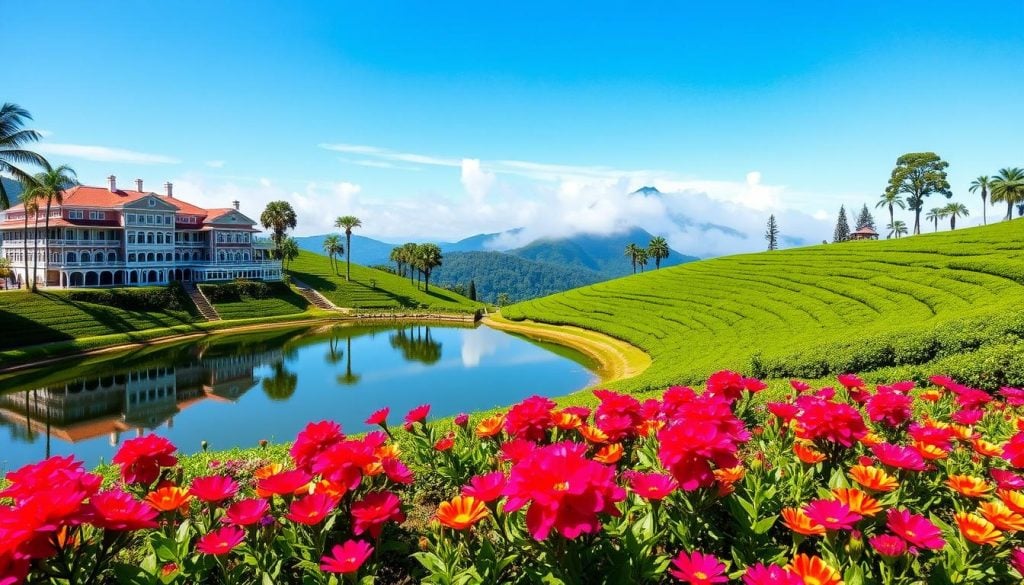
Visiting these sites offers a deep dive into Nuwara Eliya’s history and culture. It’s a chance to learn about the stories that made this place special.
| Landmark | Historical Significance | Activities |
|---|---|---|
| Gregory Lake | Colonial retreat area | Boating, picnicking |
| Grand Hotel | Example of colonial architecture | Dining, photography |
| Victoria Park | Historic botanical garden | Walks, birdwatching |
| Pedro Tea Estate | Tea production history | Tours, tastings |
These landmarks bring Nuwara Eliya’s heritage to life. Whether you’re rowing or sipping tea, every moment enriches your experience of this area.
Exploring the Viceroy’s Role in Nuwara Eliya
The Viceroy’s influence in Nuwara Eliya was key to its growth, especially in agriculture. They worked hard to make Nuwara Eliya a major player in the tea industry. Today, visitors enjoy its beautiful landscapes and rich history.
During the British colonial era, tea changed Nuwara Eliya into a major agricultural center. The Viceroy’s plans boosted the local economy and created a unique culture tied to tea. This makes Nuwara Eliya’s historical sites a top spot for those interested in its history.
| Key Contributions by the Viceroy | Description |
|---|---|
| Promotion of Tea Cultivation | The Viceroy pushed for more tea plantations, increasing production. |
| Infrastructure Development | They built roads and transport, making it easier to get to tea farms, improving trade. |
| Cultural Exchange | British officials and locals mixed, creating a special culture. |
| Environmental Awareness | They started conservation efforts, promoting green farming. |
Learning about the Viceroy’s role in Nuwara Eliya helps you see the deep history of its tea culture. This history still shapes Nuwara Eliya tourism today.
Historical Architecture in Nuwara Eliya
Nuwara Eliya is a gem of architectural beauty. It mixes colonial charm with natural wonders. As you wander through this city, you’ll see buildings that tell old stories. These sites are key attractions, drawing those who love history.
Colonial Buildings and Their Stories
The colonial buildings in Nuwara Eliya are more than just landmarks. They show the history and life of British settlers. The Grand Hotel and Hill Club are examples of elegance from that era. Each building has unique details that show British colonial style.
These sites are important landmarks. They show how the area grew under British rule.
The Influence of British Architecture
The British architecture in Nuwara Eliya shapes its landscape. The city’s layout, with its gardens and parks, reminds us of the English countryside. This influence adds to Nuwara Eliya’s unique charm.
The design of streets, public spaces, and homes adds to the area’s historical value. It makes exploring historical sites in Nuwara Eliya a must.
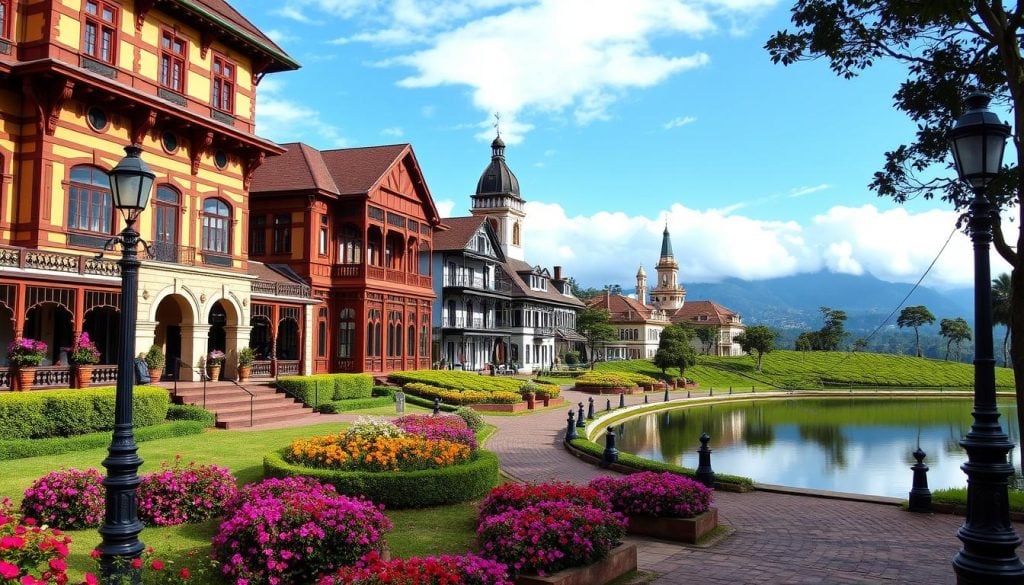
| Building Name | Architectural Style | Year Established |
|---|---|---|
| Grand Hotel | Victorian | 1891 |
| Hill Club | Colonial | 1876 |
| St. Andrew’s Church | Gothic Revival | 1824 |
| Lockwood’s Hotel | Edwardian | 1900 |
Tea Plantations: The Heart of Nuwara Eliya’s History
Tea plantations are key symbols of Nuwara Eliya’s history and growth. They have greatly influenced the area, bringing cultural exchange and a strong labor force. These sites are not just Nuwara Eliya historical sites but also top spots for Nuwara Eliya tourism.
The Role of Tea in Nuwara Eliya’s Development
Tea changed Nuwara Eliya into a top agricultural spot in Sri Lanka. It drew in many workers, creating a diverse community. Today, tea keeps the local economy strong, keeping its legacy alive.
Famous Tea Estates to Visit
Exploring Nuwara Eliya attractions leads to several famous tea estates:
- Pedro Tea Estate: It offers stunning views and tours, showing how tea is made and its history.
- Labookellie Tea Factory: Here, you can see how tea is processed and taste different blends.
- Gregory Lake Tea Estate: Near a beautiful lake, it mixes natural beauty with a rich tea history, perfect for relaxation.
These estates are key for sightseeing in Nuwara Eliya. They let visitors dive into the area’s tea culture and enjoy the scenery.
| Tea Estate | Location | Highlights | Tour Options |
|---|---|---|---|
| Pedro Tea Estate | Near Nuwara Eliya | Beautiful vistas, tea tasting | Guided tours available |
| Labookellie Tea Factory | Labookellie | Traditional tea processing | Tours with tastings |
| Gregory Lake Tea Estate | Beside Gregory Lake | Scenic beauty, relaxation | Self-guided and guided options |
These estates add to Nuwara Eliya historical sites and are key for those interested in Sri Lanka’s tea history and culture.
Key Historical Sites for Tourists
Nuwara Eliya is known for its natural beauty and rich history. Lover’s Leap Falls is a must-see, offering a stunning view. It’s also filled with romantic tales that have become part of the local culture.
Devon Falls and St. Clair’s Falls are also key spots. Devon Falls shows the area’s past in tea planting. St. Clair’s Falls, with its cascading waters, links to the tea estates that helped shape Nuwara Eliya’s economy.
Visiting these sites lets you see Nuwara Eliya’s natural beauty and history. You’ll learn about the area’s past and how it connects to today. It makes your trip more meaningful and gives you a deeper understanding of Nuwara Eliya’s history.

































